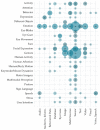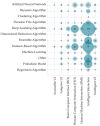Sensors and Artificial Intelligence Methods and Algorithms for Human-Computer Intelligent Interaction: A Systematic Mapping Study
- PMID: 35009562
- PMCID: PMC8747169
- DOI: 10.3390/s22010020
Sensors and Artificial Intelligence Methods and Algorithms for Human-Computer Intelligent Interaction: A Systematic Mapping Study
Abstract
To equip computers with human communication skills and to enable natural interaction between the computer and a human, intelligent solutions are required based on artificial intelligence (AI) methods, algorithms, and sensor technology. This study aimed at identifying and analyzing the state-of-the-art AI methods and algorithms and sensors technology in existing human-computer intelligent interaction (HCII) research to explore trends in HCII research, categorize existing evidence, and identify potential directions for future research. We conduct a systematic mapping study of the HCII body of research. Four hundred fifty-four studies published in various journals and conferences between 2010 and 2021 were identified and analyzed. Studies in the HCII and IUI fields have primarily been focused on intelligent recognition of emotion, gestures, and facial expressions using sensors technology, such as the camera, EEG, Kinect, wearable sensors, eye tracker, gyroscope, and others. Researchers most often apply deep-learning and instance-based AI methods and algorithms. The support sector machine (SVM) is the most widely used algorithm for various kinds of recognition, primarily an emotion, facial expression, and gesture. The convolutional neural network (CNN) is the often-used deep-learning algorithm for emotion recognition, facial recognition, and gesture recognition solutions.
Keywords: IUI; artificial intelligence; human–computer intelligent interaction; intelligent user interfaces; sensors.
Conflict of interest statement
The authors declare no conflict of interest. The funders had no role in the design of the study; in the collection, analyses, or interpretation of data; in the writing of the manuscript, or in the decision to publish the results.
Figures




















Similar articles
-
Intelligent User Interfaces and Their Evaluation: A Systematic Mapping Study.Sensors (Basel). 2022 Aug 4;22(15):5830. doi: 10.3390/s22155830. Sensors (Basel). 2022. PMID: 35957387 Free PMC article.
-
Machine Learning and Deep Learning in Medical Imaging: Intelligent Imaging.J Med Imaging Radiat Sci. 2019 Dec;50(4):477-487. doi: 10.1016/j.jmir.2019.09.005. Epub 2019 Oct 7. J Med Imaging Radiat Sci. 2019. PMID: 31601480 Review.
-
Human-computer interaction based health diagnostics using ResNet34 for tongue image classification.Comput Methods Programs Biomed. 2022 Nov;226:107096. doi: 10.1016/j.cmpb.2022.107096. Epub 2022 Aug 28. Comput Methods Programs Biomed. 2022. PMID: 36191350
-
Advancing Biosensors with Machine Learning.ACS Sens. 2020 Nov 25;5(11):3346-3364. doi: 10.1021/acssensors.0c01424. Epub 2020 Nov 13. ACS Sens. 2020. PMID: 33185417 Review.
-
Artificial intelligence in dermatopathology: Diagnosis, education, and research.J Cutan Pathol. 2021 Aug;48(8):1061-1068. doi: 10.1111/cup.13954. Epub 2021 Jan 26. J Cutan Pathol. 2021. PMID: 33421167 Review.
Cited by
-
Optimizing the impact of time domain segmentation techniques on upper limb EMG decoding using multimodal features.PLoS One. 2025 May 8;20(5):e0322580. doi: 10.1371/journal.pone.0322580. eCollection 2025. PLoS One. 2025. PMID: 40338888 Free PMC article.
-
Validation of Continuous Monitoring System for Epileptic Users in Outpatient Settings.Sensors (Basel). 2022 Apr 9;22(8):2900. doi: 10.3390/s22082900. Sensors (Basel). 2022. PMID: 35458883 Free PMC article.
-
End-User Assessment of an Innovative Clothing-Based Sensor Developed for Pressure Injury Prevention: A Mixed-Method Study.Int J Environ Res Public Health. 2023 Feb 24;20(5):4039. doi: 10.3390/ijerph20054039. Int J Environ Res Public Health. 2023. PMID: 36901051 Free PMC article.
-
Intelligent User Interfaces and Their Evaluation: A Systematic Mapping Study.Sensors (Basel). 2022 Aug 4;22(15):5830. doi: 10.3390/s22155830. Sensors (Basel). 2022. PMID: 35957387 Free PMC article.
-
Exploring emotional intelligence in artificial intelligence systems: a comprehensive analysis of emotion recognition and response mechanisms.Ann Med Surg (Lond). 2024 Jun 21;86(8):4657-4663. doi: 10.1097/MS9.0000000000002315. eCollection 2024 Aug. Ann Med Surg (Lond). 2024. PMID: 39118764 Free PMC article. Review.
References
-
- Cano S., Araujo N., Guzman C., Rusu C., Albiol-Perez S. Low-Cost Assessment of User eXperience Through EEG Signals. IEEE Access. 2020;8:158475–158487. doi: 10.1109/ACCESS.2020.3017685. - DOI
-
- Elboushaki A., Hannane R., Afdel K., Koutti L. MultiD-CNN: A multi-dimensional feature learning approach based on deep convolutional networks for gesture recognition in RGB-D image sequences. Expert Syst. Appl. 2020;139:112829. doi: 10.1016/j.eswa.2019.112829. - DOI
-
- Golestan S., Mahmoudi-Nejad A., Moradi H. A Framework for Easier Designs: Augmented Intelligence in Serious Games for Cognitive Development. IEEE Consum. Electron. Mag. 2019;8:19–24. doi: 10.1109/MCE.2018.2867970. - DOI
-
- Shaikh S., Ajmal M., Ahmed N., Badar F. Comprehensive Understanding of Intelligent User Interfaces. Int. J. Adv. Comput. Sci. Appl. 2017;8:395–401. doi: 10.14569/IJACSA.2017.080652. - DOI
-
- Pantic M., Nijholt A., Pentland A., Huanag T.S. Human-Centred Intelligent Human Computer Interaction (HCI2): How far are we from attaining it? Int. J. Auton. Adapt. Commun. Syst. 2008;1:168. doi: 10.1504/IJAACS.2008.019799. - DOI
MeSH terms
LinkOut - more resources
Full Text Sources

